| |
|
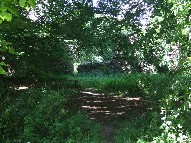 |
|
I came down out of St
Margaret, the lanes narrowing and
straightening. Sad-eyed cows huddled in
the lea of trees, as the clouds thickened
thunderously, and the air hung heavy
like a dulling wine. I had cycled
through sunshine and cloudburst across
the Saints, soaked near St Peter, warmed
and uplifted at All Saints, and I felt
sure that this was the next wave, but in
fact it would not rain again for nearly a
week. My wheels spun as the landscape
changed, and I was rolling downhill now
into the Waveney valley. I was near the
end of my journey. I had set out to visit
all twelve of the Saints in one bike
ride, and this was the last, although of
course it is not really one of the
Saints' churches at all. I first came here
in the winter of 1998. Then, it had
rained for several days, and a fierce,
blustery wind was buffeting across the
wide open plains of the Saints. My bike
had got a puncture a couple of miles away
at St Michael, so I abandoned it, to
collect it later. I'd walked into the
weather, along the narrow, hedgeless
lanes. The flat, ploughed fields gleamed
with wet flints. There was not a soul
about. It was like walking on the moon.
|
After a couple of
miles, I'd come to South Elmham Hall, in the
parish of St Cross. Here, the fields and
paths were dissolving beneath the previous days'
deluge, and I was glad I was wearing sensible
shoes. I picked my way through the farmyard mud,
a couple of hens surveying me miserably from
beneath a tractor. Ahead of me, the five bar gate
seemed a way into another world. As I opened it,
and stepped out into the field, the winter sun
lit the tree-filled valley below. Here I was
aimed. The footpaths across the Hall farm were
clearly marked, generally running along hedgerows
(hedgerows in the Saints!) and the whole area was
designated South Elmham Walks. I came down into
the valley, where the brook marked on my OS map
was a lazy flood, spreading out beyond the ends
of the flat concrete cattle bridge. But I was
impatient to get on, so I swirled through the
shallows, on my way to something I had wanted to
see since moving to Suffolk more than ten years
before.
Coming back now in
summer, more than ten years later, I thought
about the changes that Suffolk had seen since
then. In 2001, the foot and mouth epidemic had
changed rural England dramatically, closing it
off for the summer and wrecking the rural
economy. It was as if a great flock of locusts
had spread across the countryside, eating
livelihoods rather than crops. It left behind a
barer, sadder landscape. And then there was the
more insidious rise to power of the supermarkets.
Now, the East Anglian farming economy was at the
beck and call of the giants of Tesco, Sainsbury
and Wal-Mart. They dictated the prices and the
fashions in food. With one word they could wipe
out demand for a crop in mid-season, and slowly
they encouraged the industrialisation of meat
production. The old England was going for ever.
In the late 1990s, I had cycled through every
Suffolk village, visiting every Suffolk parish
church. Repeating the journey ten years on, I was
amazed by how empty the countryside had become,
and particularly by the absence of cattle, which
seemed to have been marginalised onto specialist
farms. Instead, great wastes of land had been
given over to pig production, and fields which
had been left fallow thanks to the absurdity of
the Common Agricultural Policy were now
intensively and rapaciously farmed for short-term
gain. So much of Suffolk looked like a temporary
landscape. I remembered cycling past dairy farms,
many of them with 18th and 19th century barns and
outbuildings, smelling the silage and hearing the
mournful lay of cattle, but now these same farms
were empty apart from piles of silent, rotting
machinery. It was depressing. What will become of
us, I wonder?
I cycled down to
the gates of South Elmham Hall, and was pleased
to discover that it was still in business. I
locked my bike, something I rarely do when I am
out cycling in the East Anglian countryside, but
I had a walk ahead of me, and I didn't want to
find myself stranded at the end of it. I climbed
the gate as I had ten years before. There was no
one about, no other walkers in sight. Some
beautiful cows came across to look at me. They
jostled for position, but the wire of an electric
fence held them back. There were new laminated
signs explaining how to avoid crossing fields of
cows in the Walks. This may sound like another
case of 'Health & Safety' gone mad, but in
fact a woman had been trampled to death on this
very path just a few months before. Cows are
gentle, but they are inquisitive, very big and
very stupid. If one of them thinks you are
interesting, it will follow you, and other cows
will follow her. If you walk faster, they will
walk faster to follow you, and if you run, they
will run. And you will tire or trip before they
do. The best thing to do is to stand your ground,
wave your arms, shout and clap, and shoo them
away. They'll soon forget you.
The sun came out,
the clouds evaporating as I strolled on across
the undulating fields. Ahead of me in the woods
was a mystery. An ancient flint core ruin of
uncertain origin, dated by some as early as the
7th century, and by others as late as the 15th.
It is set among towering oaks and beeches, and
surrounded by a wide, low, rectangular rampart,
which is clearly something much older, most
likely a Roman encampment. Here, half a mile from
the nearest road, in an area where the word
'road' is itself a bit of an exaggeration, I saw
for the first time the remains of the building
generally described as South Elmham Minster,
although I have also heard it referred to as a
Cathedral, a castle, a church and even a pagan
temple.
Fortunately,
thanks to archeologists, we know rather more
about it now; but in some some ways, they have
presented us with more questions than they have
answered. I stepped through the narrow gate, and
made my way across an open space into the trees.
Ahead of me, the ruins glowed in the vivid
sunlight beneath the trees.
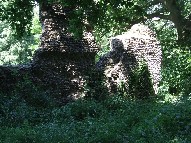 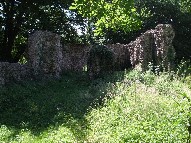 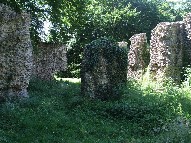 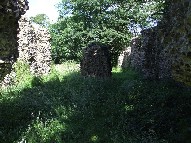 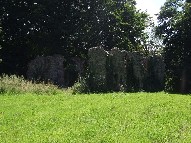
Bales of straw
were stacked haphazardly among the ghostly
shapes. I walked among them, trying to get my
bearings. This is as wild a place as any in
Suffolk, although as a result of the time when
the South Elmham Walks project received European
funding a park bench sits incongruously in the
clearing. These ruins date, almost certainly,
from slightly before the Conquest - say, about AD
1000. But the story behind it goes back to the
evangelisation of Suffolk by St Felix some 350
years earlier.
The eccesiastical
organisation of late Roman Britain is lost in the
mists. The foundations of a 4th century church
have been uncovered in Colchester, 40 miles away,
but tell us little about the bigger picture. What
we do know, though, is that in about 630 St
Felix, the first Catholic Bishop of East Anglia,
established his See at Dunmoc, probably Walton
Castle on
the Suffolk coast. However, his successors soon
moved on, and there may never have been a
Cathedral building at Walton, in the sense we
understand it today. Instead, the East Anglian
Bishops styled themselves 'Bishop of Elmham'; the
See then moved on to Thetford, and at last to
Norwich. Today, the restored Catholic Bishop of
East Anglia still has his see in Norwich, and the
Anglicans, who inherited the medieval Cathedral
at the Reformation, have their Bishop of Norwich
too.
Such simple
history suggests, of course, that this building
in the woods was Elmham cathedral, and some
guidebooks describe it as such. However, they are
wrong. For there is another Elmham in Norfolk,
known as North Elmham, and it is there that the
successors of St Felix sat and ministered ex
cathedra. But South Elmham DOES have some
Episcopal connections, and they come much later.
For it was here that that the Bishops of Norwich
had their summer retreat, and South Elmham Hall
is a surviving section of that building. It is
not unlikely that the 'Minster' had a connection
with this house, and we can fully discount the
possibility that this was ever East Anglia's
cathedral.
A more pausible
theory, but again one that doesn't bear much
examination, is that this really was a Minster -
that is to say, a kind of Cathedral outstation,
leading a group of parishes. This would neatly
explain why there are so many villages with the
name South Elmham. But it almost certainly isn't
true. Such a small-scale Ecclesiastical structure
would be unique in England; other Minsters were
homes to religious communities, carrying out the
Bishop's work in a large number of parishes (so,
for instance, Beverley, Ripon, Wakefield and
Southwell Minsters doing the Archbishop's work in
the huge diocese of York). Here, we are only 15
miles from Norwich, and there is no evidence that
there was ever a religious community in the
Saints; there was one two miles away, at Flixton, but that was an
Augustinian convent.
The most likely
explanation is that this was an extraparochial
chapel, perhaps even a chapel of ease for a now
vanished community. John Sanderson of South
Elmham Hall tells me that most archaeologists now
consider it to be the work of Herbert de Losinga,
first Bishop of Norwich, and that it was a
private chapel that may also have been the centre
of a community at some point in its life. It may
have been on the site of an earlier church, which
was on the site of a Roman temple, hence the
location within a Roman fortification (you'll
find the same thing at Burgh Castle, in Norfolk).
The villages of South Elmham take their name from
the Deanery of South Elmham, all the parishes of
which had been under the ownership of the Bishop
of East Anglia.
But there are
features of this building which call for
something more in the way of an explanation.
The church is
basically in three parts; you approach from the
east, and the further west you go, the more
substantial are the remains. Not much survives of
the chancel at all, except for a curious, square
structure set in the north wall, at an angle to
the rest of the building. I had puzzled over this
for several years, but John Sanderson explains
that it is the top of the north east corner,
which had fallen into the building at some point
and not been carted off for reuse elsewhere. The
other two parts are separated by a wall with two
apparent doorways in it. Some books describe the
western section as the base of a tower, which may
be so, although it wouldn't explain the partition
wall. A more exciting theory is that the western
part was a narthex, a common feature of Christian
basilicas in the early years; on a grand scale,
you can see what might have been here at Vezelay, in Burgundy.
| Here in
the narthex was where the uninitiated
(that is to say, the unbaptised) could
take part in the Ministry of the Word.
However, at the Creed, a curtain would be
drawn across, so that they could not
witness the most solemn mystery of the
Christian faith; the consecration and
celebration of the Mass. It is awsome enough
to think of this at Vezelay. It is a
spine-tingling thing indeed to stand in
these remote ruins, and imagine it
happening here.
Oddly in this woodland
clearing, no birds sang. There was a deep
silence, and it could have been any time.
I stood for a while, just imagining.
There was a sudden chill from the tree
shadows, and I knew it was time to go. It
was a relief to step out of the woods and
into the sunshine again. The lazy cows
watched me as I walked back along the
edges of their fields to my bike, half a
mile away. The clover hummed with bees
flitting clumsily as I climbed the hill,
and then I was off again, cycling north,
as a skylark erupted from the pasture
beside the lane, and began to sing.
|
|
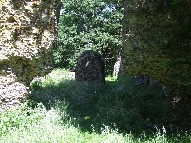 |
|
|
|

